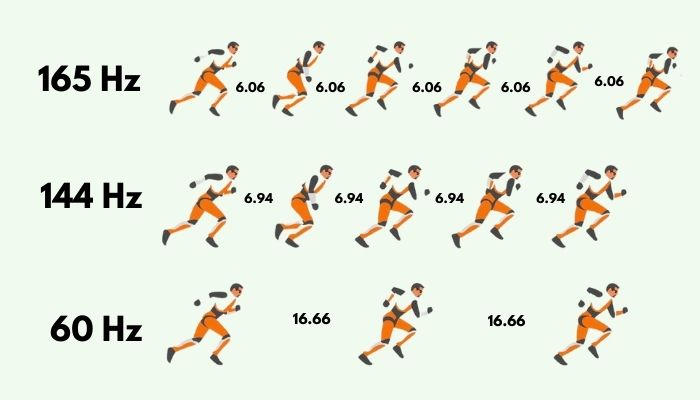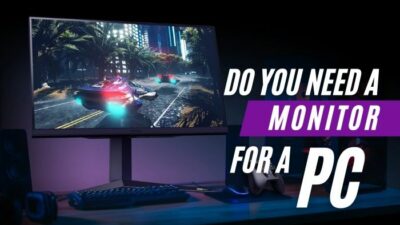Digging the internet to purchase a 144Hz gaming monitor and then discovered with a few extra bucks, you can get a 165Hz display? And there comes the obvious confusion!

The marketing policy of the big display brands made us puzzled in choosing an ideal monitor, especially when the price point of two different monitors (different display hertz) is identical.
Since you are here on this article, selecting the perfect monitor for your gaming setup won’t be an issue. I’ll discuss every point of view to decide which display hertz (144 or 165) is gonna suit you the best.
So, without any delay, let’s get started.
165Hz VS 144Hz: What are the Differences?
There’s a myth that almost every gamer believes in “human eyes can only notice 60FPS”. If that’s true, how come you can notice a sudden frame drop from 90 FPS to 60? Interesting, right?
To disclose this fictional conviction, you must understand the frame rate per second and how FPS corresponds with display hertz.
Hz clarifies the monitor’s refresh rate. To be more precise, how many pictures can display on your monitor in a second. The number of different images that appear on your screen every second ― your monitor’s display hertz.
Supposedly, you have a 60Hz monitor. So, you’ll see 60 different pictures in one second. From this point, you can clearly say, the more Hz, the better the view of display contents.
That being said, the 165Hz monitor is a clear winner in this comparison. But is it, though?
I’ve included a chart of display Hz and how effective they are on a computer for your better understanding.
Also check out our ultimate review on the best budget AIO cooler Cooler Master ML240R.
Here is the distinguished list of multiple display Hz and their viewing time for each frame:
| Refresh Rate | Frametimes per Millisecond | Different than previous |
|---|---|---|
| ● 60 Hz | ● 16.66ms/frame | Nill |
| ● 75 Hz | ● 15 ms/frame | 1.66 ms/frame |
| ● 144 Hz | ● 6.94 ms/frame | 8.06 ms/frame |
| ● 165 Hz | ● 6.06 ms/frame | 0.88 ms/frame |
| ● 240 Hz | ● 4.16 ms/frame | 1.9 ms/frame |
Look at the divergence as the frame rate increases. For instance, when a monitor’s refresh rate increases from 75Hz to144, you can notice the dissimilarities in the frame time. Whereas you had to wait 15 milliseconds (like you can differentiate that!) for the next image, it dropped to almost half.
Now, between 144 Hz and 165, the Hz difference is 21. That means a monitor with a 165 Hz refresh rate is likely to display 21 more pictures in a second.
So, what will the difference feel like in real-time?
Let’s take a look at this image. Then we can discuss the effects of display refresh rate.

At first, when you use the 165 Hz monitor for gaming or other content consumption, you’ll notice a slight improvement in the frame performance compared to a 144 Hz display. That improvement might not be noticeable if you’re a newbie. However, in case the game fluctuates a little over time, you’ll feel a less smooth viewing angle, controls are laggier, and so on.
But it all comes down to compatibility with other components. If your rig can handle the framerate in 4k quality, I think 165 Hz is slightly better than 144Hz monitors.
Wait! That’s not the final verdict. Read the following segments to finalize the monitor of your choice.
Pro Tip: Only higher refresh rate isn’t enough for better gameplay.
144 Hz: Complete Overview
If you’ve read till this point, then it’s assumed that you know what display Hz is and how it works. With a 144Hz display settled in with your gaming rig, you will notice butter-smooth gestures while playing high-resolution games.
That’s not all. To raise awareness, I’ll include the benefits and disadvantages of 144Hz monitors. Take a look if you’re planning to get a 144 Hz display.
Benefits of 144 Hz Refresh Rate
If you are upgrading from a 60 Hz monitor to 144, then there’s no need to point out the benefits. You’ll feel the difference once your eyes meet the display. But, compared with 165 Hz, there are some advantages you need to know of.
Here are the benefits of 144 Hz Monitor:
- Affordability: As I stated, Monitors with lower display Hz are more cost-effective than the higher ones. Though the difference between 144 Hz and 165 Hz is roughly 40-70 dollars, their performance can’t be discriminated against as per their value.
- Image Clarity: In my view, it’s the best feature of a 144 Hz display. Pictures appear clear as crystal while viewing contents. And the detailing of the images is genuinely captivating if the other hardware components are compatible.
Those are the common edges of the 144 Hz refresh rate. Let’s not forget that there are also some limitations to using the 144 Hz monitor. Hence comes the following section.
If you face any problem related to Nvidia then you can uninstall geforce experience app and then give it a fresh installation.
Disadvantages of 144 Hz Refresh Rate
With the benefits that I described earlier, 144 Hz monitors also have a few drawbacks. Though they are not significant, it’s worth mentioning.
Firstly, its display panel. Whether the monitor uses an IPS or TN panel, both are more expensive than they should’ve been. Also, the color combination of the TN panel is not worth the price.
And also, the 144 Hz monitors are performance hungry. You need a high-end graphics card to utilize the potential of a 144 Hz display. To render up to the monitor’s highest limit, you must have a powerful GPU installed. Otherwise, you won’t be able to feel the enhanced gaming experience.
165Hz: Good for Competitive Gaming?
Before you get to the competitive gaming section, you need to understand the limitations of 165 Hz. Once you have the proper knowledge, you’ll get to decide if that’s built for use in a gaming pit.
Like the 144Hz display, 165 Hz monitors have their own benefits and limitations. That being said, let’s discuss their characteristics.
Here are the advantages & limitations of 165 Hz monitors:
I can’t help but emphasize the benefits of 165 Hz displays. With a better viewing angle and image quality, you’ll be lost in a different world once you get your hands on the monitor. Compared to 144 Hz, it will provide a slightly smooth viewing experience with less motion blur. Though that’s not a significant amount, still, besides the better framerate than 144 Hz, you’ll notice the differences.
Nevertheless, a 165 Hz display also has a few drawbacks. The most significant one is its configuration if the price point is not considered. You have to set up the refresh rate for a 165 Hz monitor. As the monitor doesn’t appear with an in-built refresh rate, you have to configure the complex settings on your own.
Based on these attributes, you need to decide if you’re playing in a competitive atmosphere, is 165 Hz going to bring out your best output?
In my opinion, if you can manage a 4k display that provides a 165 Hz frame rate, you should go for it in the competitive gaming scenario. When competition isn’t the first priority, you should think twice beforehand about disbursing the extra cash.
pro tip: Solution to Error code 0x0001 & 0x0003 on your NVIDIA Geforc experience.
Does Hertz and Refresh rate Affect Gaming?
Basically, a higher refresh rate means a more responsive screen. Playing games on a monitor that supports higher display hertz will clearly give you an upper hand in locating enemies and tackling fast-paced games where every frame matters.
But, that scenario doesn’t only depend on your Monitor. You need substantial pieces of equipment to ensure that supremacy over other gamers. That includes your high-performing CPU with a GPU that may help you render better image quality.
How come other PC components are essential to produce better display hertz? Glad you asked.
Assuming that you have a 240 Hz monitor for gaming. When you launch a game on your rig, your monitor will require more graphical rendering from the components to produce a higher resolution. And, if your rig isn’t capable enough to produce that rendering quality, it’s likely you can’t enjoy the display potential.
So, it seems you need a monitor which is compatible with your system. Otherwise, if you get a monitor just because it has a higher refresh rate and better synching capability (V-sync/ G-sync/ Free sync) ― to run with a potato PC, it’ll definitely affect your gaming.
Find out whether your computer’s output matches your monitor’s refresh rate. You don’t want to underutilize/ overutilize your computer’s performance.
Now, would you like to get a clear answer to the queries that appeared on your mind while reading this article? Check out the following section.
Frequently Asked Questions
Can you feel the difference between 144Hz and 165Hz?
Most of the time, no. Unless you suffer from a major frame-drop while gaming, you won’t feel the differences.
Should I use 144Hz or 165Hz?
No doubt 165 Hz is better than 144 Hz display. But if you’re short on budget, I would recommend going for 144 Hz.
Can a 165Hz monitor run 240 FPS?
If you are not screen tearing, you won’t get a single FPS more than your monitor’s refresh rate.
Can I use 144Hz on a 165Hz monitor?
Yes, you can run games with 144 Hz on a 165 Hz monitor. But, if you can utilize it better, why drop it lower?
Can HDMI 2.0 run 165Hz?
Yes, it can for a 1080p display. But, for better resolutions, e.g.1440p, it depends on your GPU and the cable.
Final Verdict
Categorically speaking, 165 Hz monitors are better in every aspect than 144 Hz. However, you won’t notice the differences unless you aim for a highly competitive field.
Though having a good gaming experience doesn’t mean you have to invest a few extra bucks for slightly better performance, choosing 165 Hz over 144.
Having said that, I would recommend you get the 144 Hz monitor if you are not in hardcore competitive gaming. You can use those extra bucks on some other components.
Enjoy the butter-smooth display!




